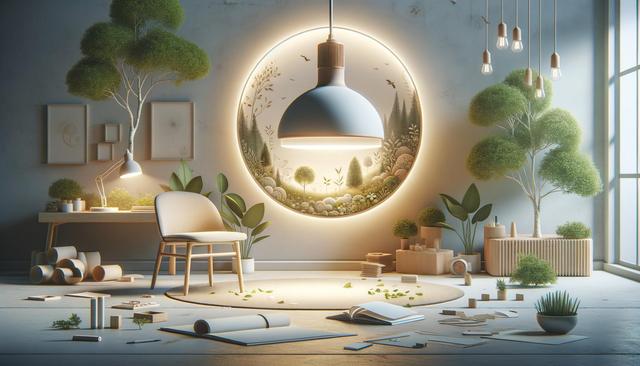Upgrade Your Lighting with These Eco-Friendly Fixtures
Switching to eco-friendly lighting is a simple yet impactful way to make your home more sustainable and energy-efficient.

Why Eco-Friendly Lighting Matters
In today’s world, energy consumption is a growing concern for both environmental and economic reasons. Traditional lighting solutions, such as incandescent bulbs, consume large amounts of electricity and contribute to higher carbon emissions. Eco-friendly lighting fixtures offer a more sustainable alternative, helping reduce your carbon footprint while saving money on utility bills. By upgrading your home or office with energy-efficient lighting, you’re not only making a positive environmental impact but also investing in long-term savings and comfort.
Eco-friendly lighting usually involves the use of LED or CFL bulbs, both of which consume significantly less energy than their traditional counterparts. These options also last longer, reducing the need for frequent replacements. Additionally, many sustainable fixtures are now designed with recyclable or biodegradable materials, further minimizing environmental impact. As more homeowners and businesses make the shift, the demand for greener technologies continues to grow, making it easier than ever to find attractive and functional options that align with your sustainability goals.
Types of Eco-Friendly Lighting Fixtures
There is a wide variety of eco-friendly lighting fixtures available on the market, each designed to meet different needs and preferences. Whether you’re looking to illuminate your living room, workspace, or outdoor area, there are sustainable options that can match your style and budget. Here are some popular types of eco-friendly fixtures:
- LED Ceiling Lights: Ideal for general lighting, these fixtures are known for their efficiency and long lifespan.
- Solar-Powered Garden Lights: Perfect for outdoor use, these lights harness sunlight during the day to illuminate your garden at night.
- Energy-Efficient Desk Lamps: Great for workspaces, these lamps often come with adjustable brightness settings and motion sensors.
- Recycled Material Fixtures: Made from repurposed or sustainable materials like bamboo or metal, these lights offer both eco-consciousness and aesthetic appeal.
When selecting a fixture, consider factors such as the room’s purpose, natural light availability, and the fixture’s energy rating. Look for labels that indicate energy efficiency certifications or eco-friendly materials to ensure you’re making a responsible choice.
Energy Savings and Long-Term Benefits
One of the most compelling reasons to switch to eco-friendly lighting is the potential for long-term cost savings. Although some energy-efficient fixtures may have a higher upfront cost, they tend to pay for themselves over time through reduced energy bills and maintenance costs. LED bulbs, for instance, can use up to 80% less energy than traditional incandescent bulbs and last up to 25 times longer.
Moreover, using smart lighting systems can amplify your savings. These systems allow you to automate lighting based on occupancy or time of day, further reducing unnecessary energy consumption. Many modern eco-friendly fixtures can be integrated with smart home devices, allowing for remote control and scheduling via mobile apps.
Here are a few long-term benefits of switching to sustainable lighting:
- Lower electricity bills
- Reduced replacement frequency
- Lower heat output, which can reduce cooling costs in warmer climates
- Enhanced property value due to modern and energy-efficient upgrades
By making the switch, you’re not only benefiting your wallet but also contributing to a broader movement toward responsible energy use and environmental stewardship.
Design and Aesthetics Without Compromise
Eco-friendly lighting no longer means compromising on style. Today’s sustainable lighting fixtures come in a wide range of designs, from minimalist and modern to rustic and vintage-inspired. Manufacturers have recognized the growing demand for fixtures that are both beautiful and energy-efficient, leading to innovative designs that suit virtually any interior or exterior space.
Materials like reclaimed wood, recycled glass, and bamboo are commonly used to create attractive, sustainable lighting options. These materials not only reduce waste but also bring a unique, natural look to your home. Many of these fixtures are hand-crafted, adding artistic value and individuality to your space.
Additionally, the light quality of eco-friendly fixtures has improved dramatically. LED technology now offers warm, soft lighting tones that mimic natural light more effectively than older bulbs. This makes them suitable for ambient lighting in living rooms, bedrooms, and other cozy spaces where atmosphere is important.
When shopping for fixtures, consider how the design complements your existing décor. Many eco-friendly options are versatile enough to blend seamlessly with a variety of styles, making it easier to upgrade your lighting without a complete remodel.
How to Make the Transition
Transitioning to eco-friendly lighting doesn’t have to happen overnight. You can start small by replacing the most frequently used bulbs in your home with LED alternatives. Gradually, you can move on to installing energy-efficient fixtures in key areas like the kitchen, bathroom, and outdoor spaces.
Here are a few steps to make the transition smoother:
- Conduct an energy audit to identify inefficient lighting areas
- Set a budget for upgrades and prioritize high-impact areas
- Research and compare different eco-friendly lighting brands and models
- Consider hiring a professional to install more complex fixtures or smart lighting systems
- Recycle your old bulbs and fixtures responsibly
Local utility companies or government programs may also offer rebates or incentives for upgrading to energy-efficient lighting. These programs can help offset initial costs and encourage broader adoption of sustainable technologies. Over time, even small changes can add up to significant energy and cost savings, making the transition both manageable and rewarding.